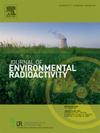Measurement and analysis of long-term variation of atmospheric 7Be activity concentrations in Dazaifu (western Japan)
IF 1.9
3区 环境科学与生态学
Q3 ENVIRONMENTAL SCIENCES
引用次数: 0
Abstract
Atmospheric 7Be activity concentration was continuously measured in Dazaifu (33°30′N, 130°30′E), western Japan, from 1999 to 2020, and its variation was analyzed. Aerosol samples were collected using quartz fiber filters. The filtered samples were punched into circles, pressed, and molded into a 2-mm-thick disk for accurate 7Be quantification. Daily 7Be data analysis, encompassing an analysis for 7765 days over 22 years, revealed a concentration range of not detected–18 mBq/m3, characterized by substantial monthly variation and smoothed annual variation. An average daily 7Be activity concentration of 5.0 ± 2.6mBq/m3 was considered to be representative at the ground-surface-level in 30–40°N.
Results from a two-way Analysis of variance (ANOVA) indicated statistical significance in monthly and annual 7Be variabilities. The monthly variability of 7Be activity concentration was approximately four times greater than the annual variability. Frequency analysis revealed that the monthly variability comprised major 12-month and minor 6-month periodicities. The substantial decrease in 7Be activity concentration during summer, a primary driver of monthly variation, was also observed at other locations in Japan, attributed to a stable high-pressure system in the Pacific Ocean that stalled over Japan’s southern seas, followed by the inflow of air masses containing low 7Be activity concentrations. The annual variation was primarily influenced by the 11-year solar activity cycle, which affects the intensity of cosmic rays that produce 7Be.
日本西部大宰府地区大气7Be活度浓度长期变化的测量与分析
1999 - 2020年连续测定了日本西部大宰府(33°30′n, 130°30′e)地区大气7Be活度浓度,并分析了其变化规律。气溶胶样品采用石英纤维过滤器采集。过滤后的样品被打孔成圆圈,压紧,模压成2毫米厚的圆盘,用于精确的7Be定量。每日7Be数据分析,包括22年来7765天的分析,揭示了未检测到的浓度范围- 18 mBq/m3,其特征是显著的月度变化和平滑的年度变化。在30-40°N地区,平均每日7Be活性浓度为5.0±2.6mBq/m3,具有代表性。双向方差分析(ANOVA)的结果显示,月度和年度7Be变量具有统计学意义。7Be活性浓度的月变异性约为年变异性的4倍。频率分析显示,月度变异包括主要的12个月周期和次要的6个月周期。在日本其他地区也观察到夏季7Be活动浓度的大幅下降,这是月度变化的主要驱动因素,原因是太平洋上一个稳定的高压系统在日本南部海域停滞,随后流入的气团含有低7Be活动浓度。年变化主要受到11年太阳活动周期的影响,太阳活动周期影响产生7Be的宇宙射线的强度。
本文章由计算机程序翻译,如有差异,请以英文原文为准。
求助全文
约1分钟内获得全文
求助全文
来源期刊

Journal of environmental radioactivity
环境科学-环境科学
CiteScore
4.70
自引率
13.00%
发文量
209
审稿时长
73 days
期刊介绍:
The Journal of Environmental Radioactivity provides a coherent international forum for publication of original research or review papers on any aspect of the occurrence of radioactivity in natural systems.
Relevant subject areas range from applications of environmental radionuclides as mechanistic or timescale tracers of natural processes to assessments of the radioecological or radiological effects of ambient radioactivity. Papers deal with naturally occurring nuclides or with those created and released by man through nuclear weapons manufacture and testing, energy production, fuel-cycle technology, etc. Reports on radioactivity in the oceans, sediments, rivers, lakes, groundwaters, soils, atmosphere and all divisions of the biosphere are welcomed, but these should not simply be of a monitoring nature unless the data are particularly innovative.
 求助内容:
求助内容: 应助结果提醒方式:
应助结果提醒方式:


